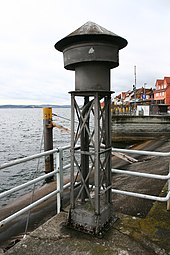Foghorn

The fog horn is a signal horn for generating sound signals or fog signals, also called typhon in shipping . It can be delivered from ships or from lighthouses. It was invented by Celadon Daboll in 1851 and gradually replaced the fog bell in the second half of the 19th century , which was far too difficult to hear. Other methods of alarm , such as firing a cannon , had also proven ineffective. The fog horn serves as a warning in shipping, even when visibility is poor, to protect road users from approaching the coast or other ships that are too dangerous.
Working principle
Daboll combined the principle of sound generation in the clarinet with the directional sound radiation of a trumpet : Compressed air is passed over a small metal plate and causes it to vibrate . The sound thus generated then leaves the horn directed over the bell. This type of foghorn is also called Daboll trumpet after its inventor in the English-speaking world . For the functional principle, see also Macrophone .
Compressors powered by steam engines or Stirling engines and fired with coal or oil were mainly used to generate compressed air . In the middle of the 19th century a horse treadmill was occasionally used to drive the air pump .
Foghorn at Ardnamurchan Lighthouse , Scotland
Range
Foghorns can be identified at sea based on their rhythm, typical shapes are e.g. B.
- 3 seconds on, 27 seconds off
- 4 seconds on, 16 seconds off
- 5 seconds on, 8 seconds off, 5 seconds on, 42 seconds off
The sound frequency of a fog horn is chosen as low as possible, since the attenuation of the sound in the air increases with increasing frequencies.
Large fog horns generate a sound pressure level of 140 dB (A) and thus give a range of 3 nm (approx. 5 km), according to some data even 8 nm (approx. 13 km) or, as in the report from 1872, 20 to 25 miles. Good fog horns for pleasure craft reach 116 dB (A) at 220 Hz and can be heard from 500 m away.
Alternatives
In the early 20th century, many daboll trumpets were replaced by more effective principles. These include:
- Fog horns with membranes
- Steam mist pipes invented by Robert Foulis
- Fog sirens
- Diaphones
- Membrane transmitter
Other signaling devices on a ship are the Colombian signaling device , the rigging and the typhon.
Provisions
According to the International Regulations of 1972 for the Prevention of Collisions at Sea ( Collision Prevention Rules , KVR for short), Annex III (Technical Details of Sound Signal Systems), the basic frequencies of ship whistles are between 70 and 700 Hz (low tones in large ships) and the required sound pressure levels in 1 m distance is up to 143 dB, whereby ship personnel may be exposed to up to 110 dB.
Part D of the Collision Prevention Rules (Rules 32–37) contains provisions on the use of fog horns on ships.
Since 2002, large ships have been required to have a digital listening post . A microphone picks up sound signals between 70 and 820 Hertz; a digital filter determines whether the sound is from a foghorn. If so, they will be played over the loudspeaker on the bridge. There are also devices that can determine and show which direction the signal is coming from.
Artistic use
In 1997, Jason Gorski experimented with discarded, air-powered foghorns on San Francisco Beach. They were 70 cm long, 30 kg in weight, had a membrane diameter of 8 cm and generated 140 dB (A). Gorski put the beach visitors and the police in a lot of confusion with his concert. He modulated the sounds produced by regulating the air supply and by inserting objects into the horn. During his performance he wore a special full-body soundproofing suit. According to him, the sound drama was best enjoyed a mile or two away.
Hyler Bracey built some fog horns into a bizarre vehicle. His pictures clearly show the dimensions of the horns.
Web links
Individual evidence
- ^ Detroit Daily Press, 1872
- ^ Rules for the prevention of collisions (text of the annex to Section 1 of the Ordinance on the International Regulations of 1972 for the Prevention of Collisions at Sea)
- ↑ Resolution MSC.99 (73), adopted on December 5, 2000: Adoption of Amendments to the International Convention for the Safety of Life at Sea, 1974 (PDF).
- ↑ Sound Signal Direction Detector. Product description from the supplier Zöllner, Kiel (PDF) ( Memento from January 10, 2014 in the Internet Archive ).
- ↑ Ships, hear the signals! In: Deutsche Seeschifffahrt. January 2014, p. 44ff.





